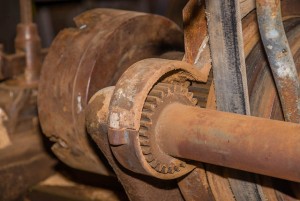 Dirt and dust may appear innocuous when flying around an industrial plant. It may seem such tiny particles can’t possibly cause major damage. However, even the smallest contaminants pose a real threat to gearbox maintenance. Ultimately, dirt, moisture, radiation, process chemicals and other small particulates can cause machine failure unless plant technicians take care to prevent contamination.
Dirt and dust may appear innocuous when flying around an industrial plant. It may seem such tiny particles can’t possibly cause major damage. However, even the smallest contaminants pose a real threat to gearbox maintenance. Ultimately, dirt, moisture, radiation, process chemicals and other small particulates can cause machine failure unless plant technicians take care to prevent contamination.
Understanding How Contaminants Cause Machine Failure
Lubrication is the lifeblood of any mechanical system. Oil is required to keep moving parts operating smoothly, transmitting force through rotation while minimizing friction. When oil is contaminated, lubrication across the system suffers. Deteriorating lube continues to interact with every moving surface, leading to excessive wear and eventual failure.
Advances in gearbox design have made contamination prevention even more important. Surface hardening techniques and improved metallurgy have allowed gearboxes to shrink in size. Surfaces are often razor thin and extremely hard, to minimize sliding wear. However, particles can still cause rolling wear, which occurs at the gear tooth pitch line, where load transference occurs. In the load zone, a squeezed particle can fatigue even hardened metals. A tiny crater can be left behind, making the surface more susceptible to wear and tear. Finally, many modern lineups run extremely hot and under overloaded conditions, making proper lubrication even more critical.
Contamination ingress occurs in a few predictable places on a gearbox: The seals and breathers. Additionally, contamination can occur during maintenance, such when refilling or replacing lube. Operating conditions also impact contamination rates; wet surroundings will increase the chance of moisture contamination, while dry, windy circumstances may force silica-based contaminants into outdoor equipment. Mines may suffer coal dust or iron dust contamination, while paper mills are more likely to see process chemical contamination.
We encourage you to call our staff for more detailed contamination advice for your operation. Our technicians are experts in all aspects of gearbox maintenance, including contamination avoidance. Still, there are some general habits that will prevent contamination in all industrial situations.
Best Practices for Preventing Lubricant Contamination
• Prioritize and Protect Seals. They are your first line of defense against contamination. Investments in high-quality seals will pay off over time, as less maintenance and replacement will be required. Avoid rinsing seals with high-pressure sprays if possible. In situations where high-pressure spraying is inevitable (such as in food manufacturing), install seal guards.
• Use Quick-Connect Couplings. Contamination is less likely when couplings are easy to install. Installation that takes minutes rather than hours not only reduces downtime; it also minimizes the chance that contaminants will enter the system.
• Flush the System after Installation and Maintenance. Manufacturers may leave contaminants inside gearboxes. Some may offer to clean components prior to shipping, for a fee. Unless you’re absolutely certain a new component is 100% contaminant-free, lubrication should be flushed through the entire line immediately following installation. The same practice should be applied after intrusive service. If the system has been exposed to the open air, flushing is a good idea.
• Select the Right Lubrication. Manufacturer’s recommendations should be taken into account. The operating environment is also key. An out-of-the-way machine will likely not be lubricated as often, so higher quality lube is ideal. Atmospheric conditions, general site cleanliness, and overloading should also be considered when selecting oil, as well as any previous challenges with this machine.
• Be Vigilant During the First Few Weeks of Operation. Regular monitoring of oil condition is especially important in the initial weeks and months following installation. Operators should test for metals, dirt, water, acid, and viscosity to assess whether reservoir cleaning and/or an oil change are required.
Proper lubrication storage, regular equipment maintenance, and consistent oil analysis are also key practices for maximizing lubricant efficiency and minimizing contaminant damage.
Contamination is the number one cause of failure in mechanical operations. Microscopic particles that are invisible to the human eye can wreak havoc on machinery, contaminating lubrication and eventually leading to overall failure. To prevent contact fatigue and maximize the lifespan of machine components, contamination prevention is key.
[Photo from Darron Birgenheier via CC License 2.0]
Posted under Machinery Maintenance on Tuesday, August 25th, 2015
